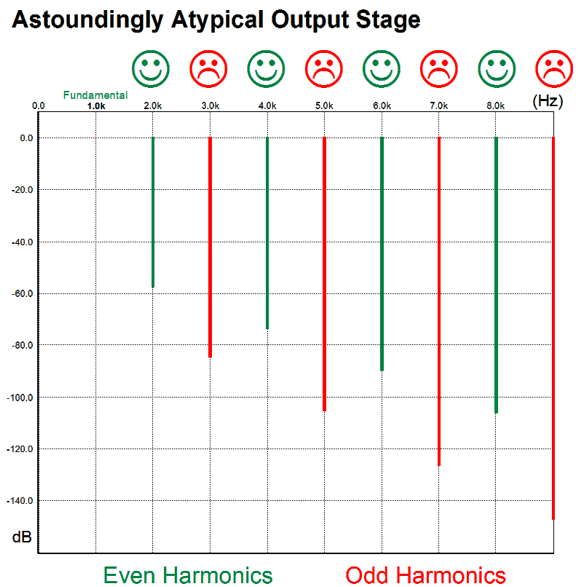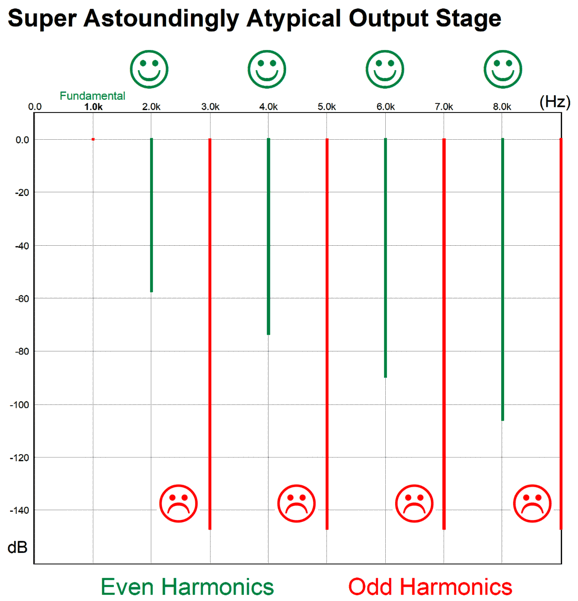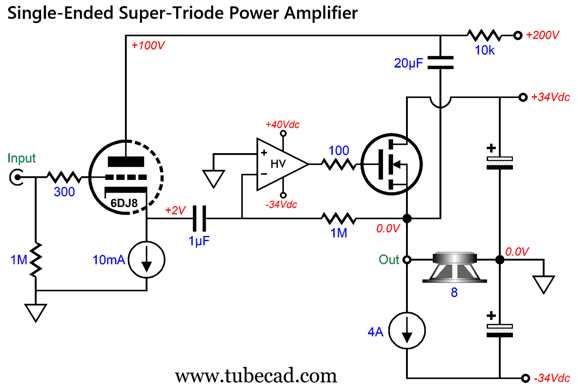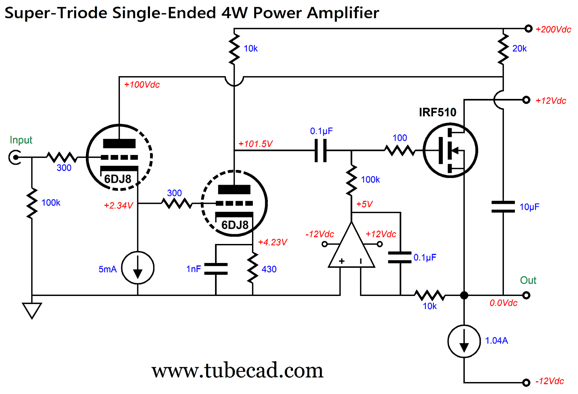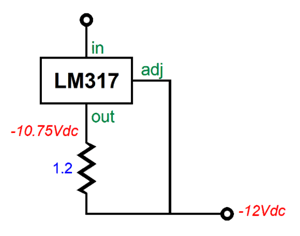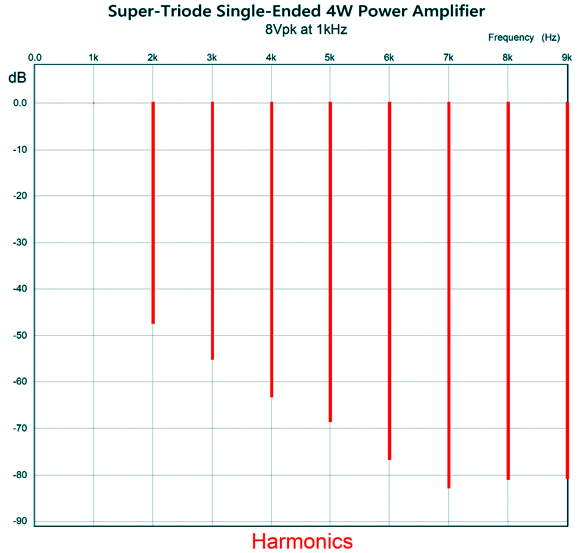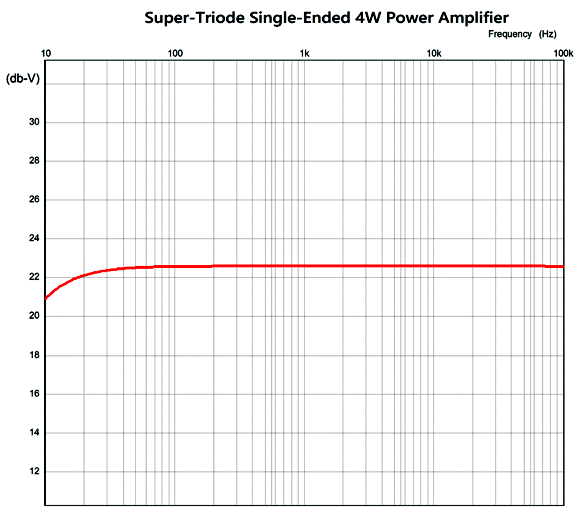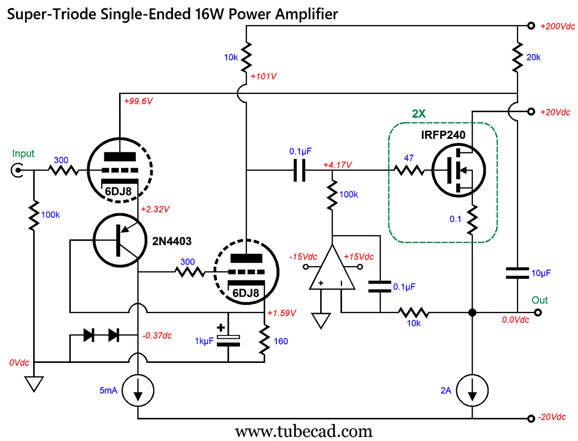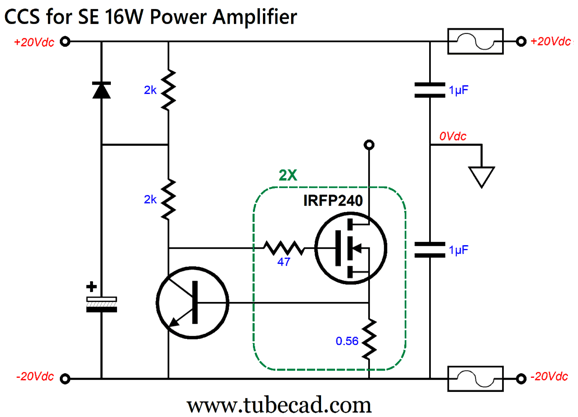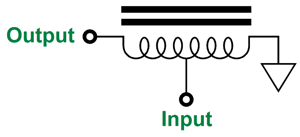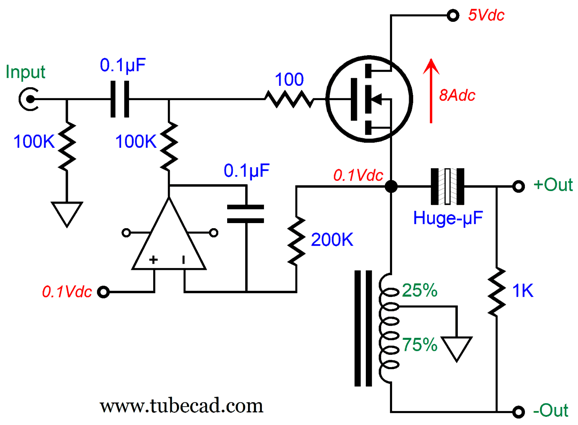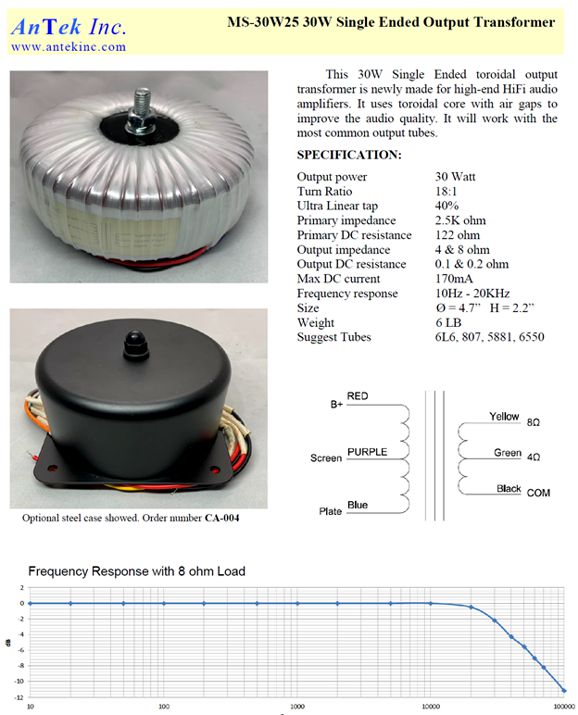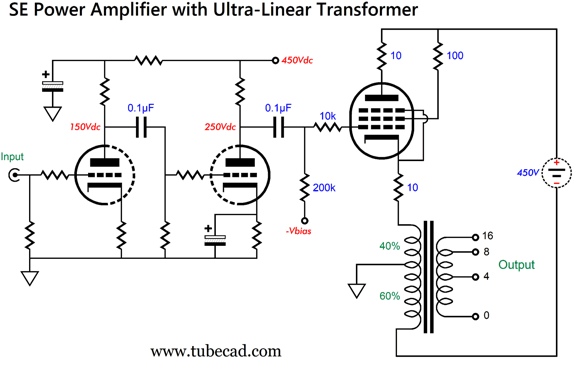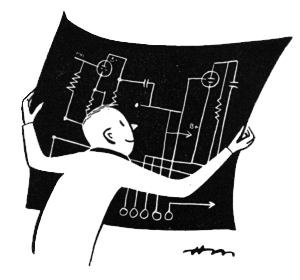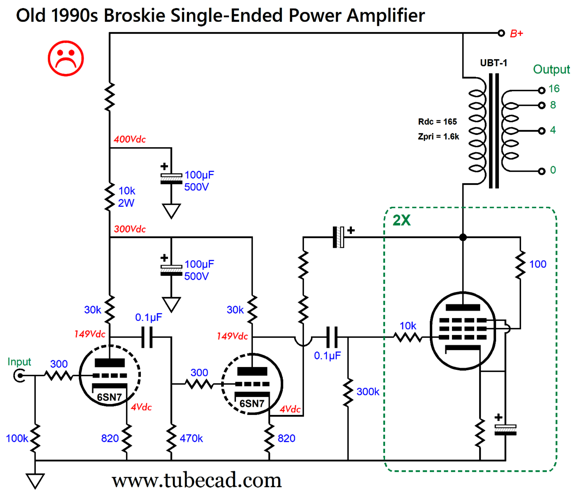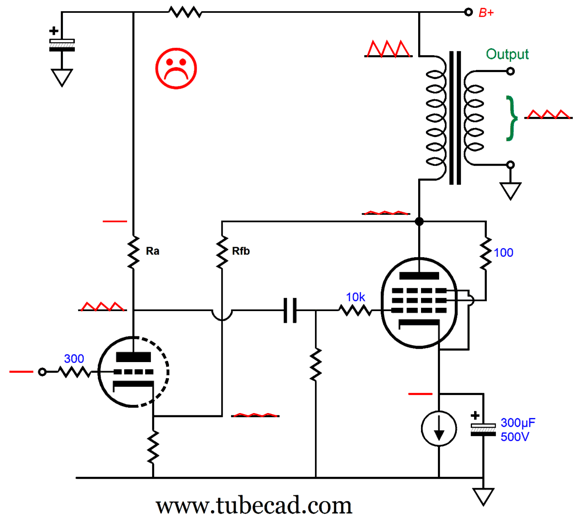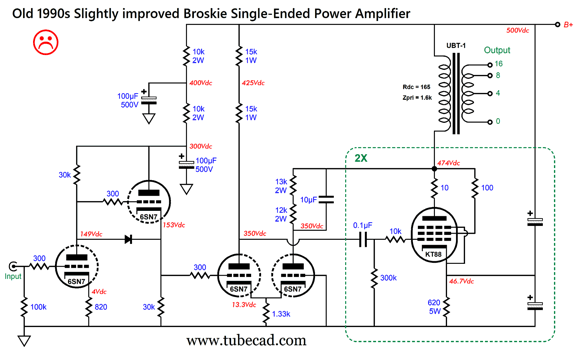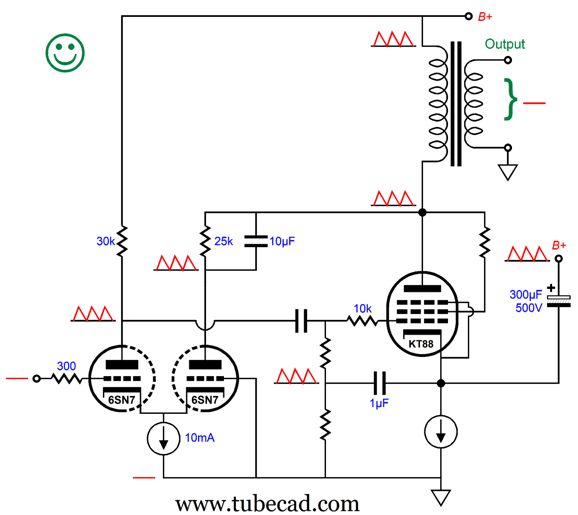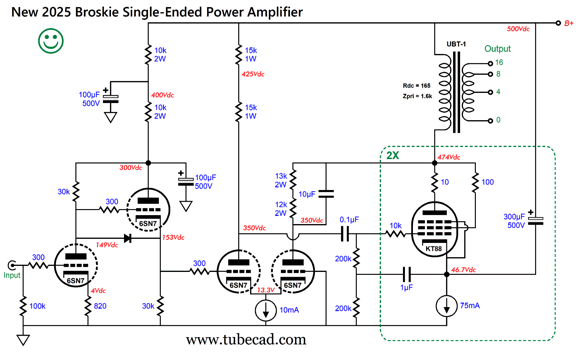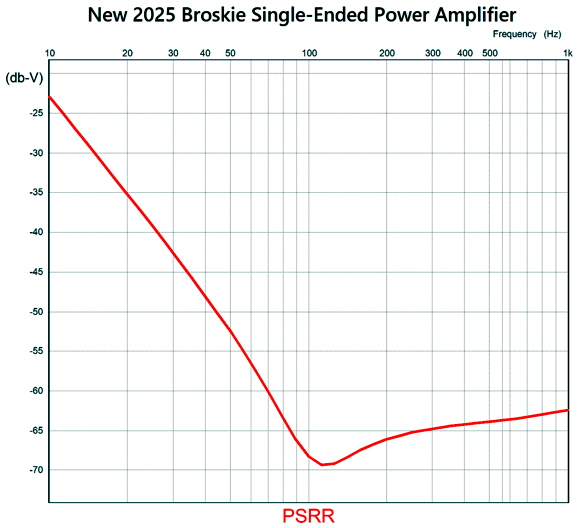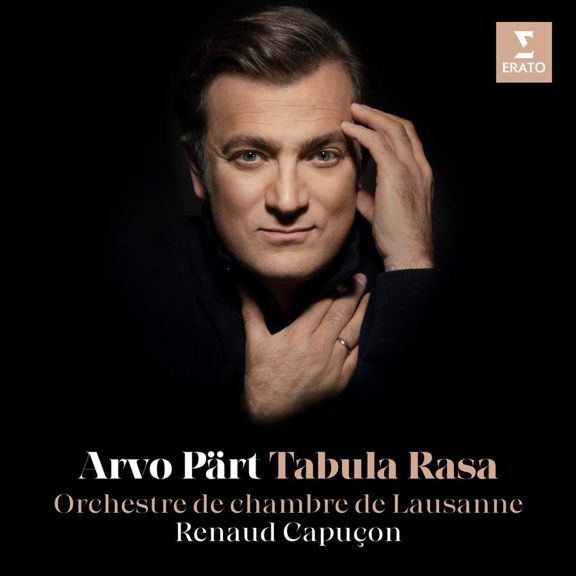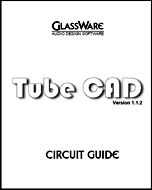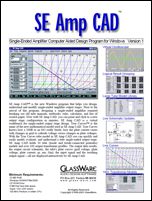| John Broskie's Guide to Tube Circuit Analysis & Design |
| May 23 2025 | Post Number 621 |
||||
Even More Single-Ended Designs
Here the push-pull harmonic structure is inverted, as the odd harmonics are reduced more than the even-order harmonics. Ideally, we want something more like a Super-Astoundingly-Atypical harmonic structure:
This sonic overlay would exhibit the same THD harmonic distortion as a typical push-pull high-end amplifier. We would fall out of our designer listening chairs, however, upon hearing it produce such sweet and beguiling sound, as the sonic overlay greatly undid the all too prevailing notched-even-harmonics sound that had permeated our lives and oppressed our ears. It is unnatural, just as unnatural as is the push-pull sonic signature, but just as eyeglass lens are not perfectly flat, this Super-Astoundingly-Atypical harmonic structure is the needed inversion of notched-even-harmonics sound. Yes, two wrongs can make a right—sometimes.
Single-Ended Super-Triode
All the solid-state devices work to impose the solitary triode's transfer function upon the amplifier's output—hence, the super-triode moniker. Of course, we all vary in our tolerance of the inclusion of solid-state devices in our tube-based audio designs. Some balk at even the use of solid-state rectifiers; others, at OpAmp-based DC servos. In fact, an all-tube super-triode power amplifier could be built by using power pentodes as the output devices. On the other hand, part of the appeal of a hybrid super-triode power amplifier is the lower cost and the lower heat dissipation, along with greater power output. What if we add a bit more tube to the topology shown above, so as to sweeten the deal further? With the ±12Vdc bipolar power supply rails and the 1.04A constant-current source, the biggest output voltage swing this amplifier is capable of delivering is 8Vpk, which translates into 4W of power into an 8-ohm loudspeaker. Considering that 300B-based 1W single-ended OTL amplifiers are made and bought (at huge expense), the 4W of output seems almost overly indulgent. The way this amplifier works is that the input 6DJ8 triode operates under near constant-current draw, as the following 6DJ8 triode, much in the same way as the OpAmp did in the original version, amplifies and inverts the AC signal present at the input triode's cathode. The IRF510 N-channel MOSFET works as a unity-gain source follower that relays the amplified signal to the loudspeaker. The 10 µF capacitor then relays the output signal to the input triode's plate, thereby completing the negative feedback loop. A 6DJ8 presents an amplification factor (mu) of around 32, which divided by 8Vpk yields a 4:1 ratio, which is a small fraction of what the OpAmp would deliver. Nonetheless, the input triode controls the amplifier's output. The 1kµF capacitor shunting the 910-ohm cathode resistor increases the gain of the secondary 6DJ8 triode. The OpAmp works as a DC servo to keep the output DC offset low. Note the 10k and 100k resistors and the two 0.1µF capacitors used in the servo. These values are not arbitrary, as they were chosen to prevent low-frequency peaking. The 1.04A constant-current source can be made from an LM317:
The SPICE-generated Fourier graph at full output shows the single-ended cascade of harmonics.
The frequency graph reveals a flat plot-line:
The IRF510 is a wimpy TO-220 power MOSFET, but it presents a truly low input capacitance. If greater output power is desired, we could use the beefier IRFP240 and greater bipolar power supply rail voltages. This super-triode single-ended power amplifier delivers 16W into 8-ohm loads and dissipates 80W at idle, making for only 20% efficiency, which is close to the theoretical maximum of 25% for a constant-current source-loaded single-ended output stage. The 2N4403 PNP transistor functions as an emitter follower and creates an inverted cascode with the input triode. The resulting open-loop gain is huge, much closer to what an OpAmp would deliver. In other words, the input triode comes much closer to operating under a constant-current draw. The 2A constant-current source could be made from another pair of IRFP MOSFETs:
Note that if either fuse blows, the constant-current source shuts down. This is important, as we do want the CCS pulling down the output to the negative rail when the top fuse blows.
More Single-Ended Tapped-Inductance Designs
The OpAmp seeks to establish a DC voltage drop of 0.1V across the top 25% of the inductor's winding. Since 8A of current flows through that portion of the winding, the DC resistance must equal 0.0125 ohms. This circuit looks like a power buffer, but it is actually and amplifier with a gain of close to +12dB (1:4). In fact, if the center-tapped fell at 50% of the winding, this circuit would qualify as a Circlotron, as the defining feature of the Circlotron is that the ground situates mid load. Of course, using a center-tapped inductor would halve the gain. Many single-ended output transformers intended for use with output tubes come with an ultra-linear tap on the primary, usually at 40% of the winding, for example, the AnTek MS-30W25, a 30W single-ended output transformer.
By the way, when reviewing single-ended output transformer specs, do some simple math. Square the maximum current and multiply the result against half the primary impedance; this is the maximum output power. Next, take the primary impedance and divide it by the maximum current flow; this is the maximum required voltage swing needed to deliver the maximum output power. In this example, we get 36W and 425Vpk. We can also work backwards. For example, say that we are willing to restrict ourselves to the published 30W of output power. We multiply 30W against twice the primary impedance, and we then take the square-root of the product to get the maximum voltage swing needed to establish 30W; in this example, 30 x 5k and √150k, which yields 387Vpk. Next, we divide 387V by the primary impedance, 2.5k, and get 155mA as the required idle current flow. (Of course, the actual transformer's primary and secondary DCRs will subtract from the potential power output.) I am sure that we will agree that the math was super simple. Yet, yet many transformer spec sheets and commercially-made single-ended power amplifiers fail the math tests. We now move on to exploiting the ultra-linear tap. If we ground the ultra-linear tap and use a floating high-voltage power supply, we can create a quasi-cathode-follower output stage. The cathode-follower output stage offers low distortion and low output impedance, but requires a huge input signal, which seldom can be created without using an insanely high B+ voltage for the driver stage. In contrast, this output stage straddles being a cathode-follower buffer and a grounded-cathode amplifier. Since the ultra-linear tap occurs at 40% of the primary winding, we only need 40% of the input voltage swing that the pure cathode-follower output stage needs. Bear in mind that the floating power supply means that the output tube still sees the same load-line that it would in the conventional arrangement. On the other hand, if we ground the ultra-linear tap and use a fixed high-voltage power supply that also terminated into the ultra-linear tap, the output tube would see 1/16th of the primary impedance. Note that the output tube uses both fixed bias and cathode bias, as 40% of the primary DCR becomes a faux cathode resistor in DC terms.
Improved Old Single-Ended Design The negative feedback did yield these benefits, but it worsened the PSRR. The problem was that the negative feedback made for a cleaner output and improved PSRR at the output tube's plate, but not at the secondary.
The output transformer now saw most of the power-supply noise as a signal source, which it dutifully relayed to its secondary. Ideally, the primary should see 100% of the power-supply noise at both ends of its primary, so that the transformer might reject the noise. This led to my revised version: This is the schematic I had found. My thinking was that I could use a triode in place of a negative feedback resistor, but I soon realized that would create too high a plate voltage on the triode. I then added a bypassed plate resistor to the circuit. The negative feedback loop is still there, although most would not see it. The PSRR did improve, but the distortion was higher than I expected. As I stared at the circuit, I saw that what was needed was a shift from ground referenced to B+ voltage referenced.
The added two constant-current sources decouple the output stage from ground, moving the signal reference from ground to the B+ voltage. In addition, we get auto-bias for the output triode. The PSRR, paradoxically enough, improves dramatically, as the output transformer's primary is a fundamentally differential device that is blind to common-mode signals, which in this example is the power-supply noise. I fired up my SPICE program and modeled the following circuit: The PSRR results in SPICE simulations were stellar.
The deepest dip occurs just were we want it to at around 120Hz. The output impedance was a tad over 1 ohms, and the distortion graph shows a lovely single-ended cascade of harmonics. 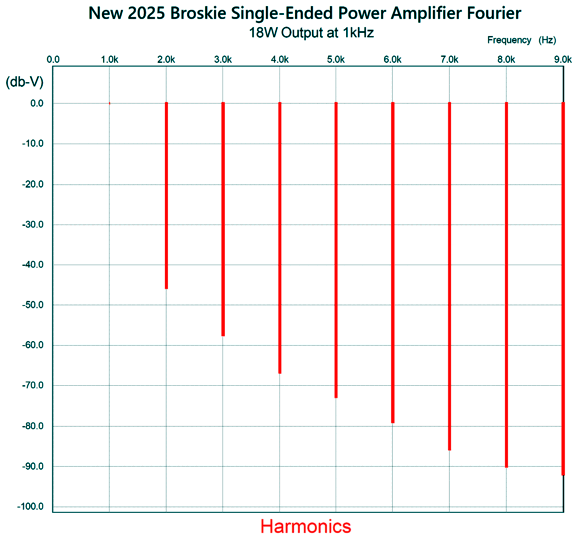
Without the negative feedback, all the harmonics rise by about 10dB.
More on Digital Domestication: -CD² I am sure that 99% of the general public would be perfectly happy with the resulting sound; and 75% of hardcore audiophiles would also be pleased. The remaining 25%, mostly made up of tube-loving types, would quibble, finding the stereo image not as wide nor as deep, the highs not as pellucid, the voices not yet completely lifelike, but they would find the bass suitably punchy. In addition, the damn little amplifier puts out something like 60W to 100W, which adds its own compelling appeal. I was happy to replace it with my new single-ended amplifier with the re-cap job, but I was only 30% more happy. Here's the thing: I paid a little over $100 for the class-D stereo amplifier. If I had two of them, I bet the imaging would improve by 10%. Here is another thing: the newest (and the best) class-D amplifiers use far faster output devices and some of them now attach the NFB loop after the output low-pass filter, not before it, which makes a huge difference and hadn't—and couldn't be— done before. If we gave the new class-D amps an old-fashioned big conventional power supply, as are used in most high-end amplifiers, not the tiny switching power supplies used with most class-D amps, I bet they would really sing. In sum, de-jittering and re-clocking mojo changes more than just digital playback. For example, headphone listening reveals the upgrade in sonic splendor marvelously. My $600 headphones now sound, stunningly, twice as expensive. Layered sonic imaging becomes a reality. Solid-state headphone amplifiers sound more tube-like and tube headphone amplifier sound more lifelike.
Music Recommendation: Prestomusic
In 1984, he was discovered by the great recoding label, ECM, which released the first recording of Tabula Rasa. I discovered this CD in the early 1990s and instantly fell in love with it and his music, which my 30 CDs devoted to his compositions testifies to on its behalf. In other words, I am always on the outlook for new recordings of his works, which explains how I discovered Renaud Capucon's latest album that completes the Tabula Rasa circle. Wow! That is what I uttered after hearing just the first minute. I am used to first-rate performances, but not to, sadly, first-rate recordings. This combines both. If I play one track from it, I have to play the entire album. Absolutely first-rate.
//JRB
Did you enjoy my post? Do you want to see me make it to post 1,000? If so, think about supporting me at Patreon.
User Guides for GlassWare Software
For those of you who still have old computers running Windows XP (32-bit) or any other Windows 32-bit OS, I have setup the download availability of my old old standards: Tube CAD, SE Amp CAD, and Audio Gadgets. The downloads are at the GlassWare-Yahoo store and the price is only $9.95 for each program. So many have asked that I had to do it. WARNING: THESE THREE PROGRAMS WILL NOT RUN UNDER VISTA 64-Bit or WINDOWS 7, 8, and 10 if the OS is not 32-bit or if it is a 64-bit OS. I do plan on remaking all of these programs into 64-bit versions, but it will be a huge ordeal, as programming requires vast chunks of noise-free time, something very rare with children running about. Ideally, I would love to come out with versions that run on iPads and Android-OS tablets.
|
I know that some readers wish to avoid Patreon, so here is a PayPal button instead. Thanks. John Broskie
John Gives
Special Thanks to the Special 89 To all my patrons, all 89 of them, thank you all again. I want to especially thank
I am truly stunned and appreciative of their support. In addition I want to thank the following patrons:
All of your support makes a big difference. I would love to arrive at the point where creating my posts was my top priority of the day, not something that I have to steal time from other obligations to do. The more support I get, the higher up these posts move up in deserving attention. If you have been reading my posts, you know that my lifetime goal is reaching post number one thousand. I have 380 more to go. My second goal was to gather 1,000 patrons. Well, that no longer seems possible to me, so I will shoot for a mighty 100 instead. Thus, I have just 11 patrons to go. Help me get there. Thanks.
New URL of the GlassWare website |
||||
| www.tubecad.com Copyright © 1999-2025 GlassWare All Rights Reserved |

